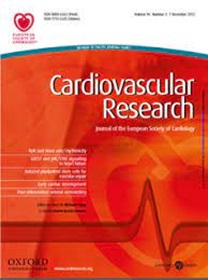Toll-like receptor 4 induces trained innate immune tolerance in the heart in a model of stress-induced cardiomyopathy.
IF 13.3
1区 医学
Q1 CARDIAC & CARDIOVASCULAR SYSTEMS
引用次数: 0
Abstract
AIMS Although the ability of the heart to adapt to environmental stress has been studied extensively, the molecular and cellular mechanisms responsible for cardioprotection are not yet fully understood. In this study, we sought to elucidate these mechanisms for cytoprotection using a model of stress-induced cardiomyopathy. METHODS AND RESULTS We administered Toll-like receptor (TLR) agonists or diluent to wild-type mice and assessed for cardioprotection against injury from a high intraperitoneal dose of isoproterenol (ISO) administered 7 days later. Cardioprotective effects were analyzed through serum cardiac troponin I levels, immune profiling via flow cytometry, echocardiography, and multiomic single-nuclei RNA/ATAC sequencing. Pretreatment with the TLR4 agonist lipopolysaccharide (LPS), but not TLR1/2 or TLR3 agonists, conferred cardioprotection, as demonstrated by reduced cardiac troponin I leakage, decreased inflammation, preserved cardiac structure and function, and improved survival. Remarkably, LPS-induced tolerance was reversed by β-glucan treatment. Multiomic analysis showed that LPS-tolerized hearts had greater chromatin accessibility and upregulated gene expression versus hearts treated with LPS and β-glucan (reverse-tolerized). LPS tolerance was associated with upregulation of interferon response pathways across various cell types, including cardiac myocytes and stromal cells. Blocking both type 1 and 2 interferon signaling eliminated LPS-induced tolerance against ISO, while pretreatment with recombinant type 1 and 2 interferons conferred cardiac protection. Multiomic sequencing further revealed enhanced cytoprotective signaling in interferon-treated hearts. Analysis of cell-cell communication networks indicated increased autocrine signaling by cardiac myocytes, as well as greater paracrine signaling between stromal cells and myeloid cells, in LPS-tolerized versus reverse-tolerized hearts. CONCLUSIONS LPS pretreatment confers cardiac protection against ISO-induced injury through TLR4-mediated type 1 and 2 interferon signaling, consistent with trained innate immune tolerance. The observation that LPS-induced protection in cardiac myocytes involves both cell-autonomous and non-cell-autonomous mechanisms underscores the complexity of innate immune tolerance in the heart, warranting further investigation into this cardioprotective phenotype.toll样受体4在应激性心肌病模型中诱导训练的先天性免疫耐受。
虽然心脏适应环境压力的能力已被广泛研究,但负责心脏保护的分子和细胞机制尚未完全了解。在这项研究中,我们试图通过应激性心肌病模型来阐明细胞保护的这些机制。方法和结果我们给野生型小鼠注射toll样受体(TLR)激动剂或稀释剂,并评估7天后给药高剂量异丙肾上腺素(ISO)对心脏损伤的保护作用。通过血清心肌肌钙蛋白I水平、流式细胞术、超声心动图和多组单核RNA/ATAC测序分析心脏保护作用。预处理TLR4激动剂脂多糖(LPS),而不是TLR1/2或TLR3激动剂,具有心脏保护作用,如减少心肌肌钙蛋白I泄漏,减少炎症,保留心脏结构和功能,提高生存率。值得注意的是,β-葡聚糖处理逆转了lps诱导的耐受性。多组学分析显示,与LPS和β-葡聚糖(反向耐受)处理的心脏相比,LPS耐受的心脏具有更高的染色质可及性和上调的基因表达。LPS耐受性与各种细胞类型(包括心肌细胞和基质细胞)中干扰素反应通路的上调有关。阻断1型和2型干扰素信号可以消除lps诱导的对ISO的耐受,而重组1型和2型干扰素预处理可以保护心脏。多组测序进一步揭示了干扰素处理心脏细胞保护信号的增强。细胞-细胞通信网络分析表明,在lps耐受与反向耐受的心脏中,心肌细胞的自分泌信号传导增加,基质细胞和髓细胞之间的旁分泌信号传导也增加。结论slps预处理通过tlr4介导的1型和2型干扰素信号传导,对iso诱导的心脏损伤具有保护作用,与训练的先天免疫耐受一致。lps诱导心肌细胞的保护涉及细胞自主和非细胞自主机制,这一观察结果强调了心脏中先天免疫耐受的复杂性,需要进一步研究这种心脏保护表型。
本文章由计算机程序翻译,如有差异,请以英文原文为准。
求助全文
约1分钟内获得全文
求助全文
来源期刊

Cardiovascular Research
医学-心血管系统
CiteScore
21.50
自引率
3.70%
发文量
547
审稿时长
1 months
期刊介绍:
Cardiovascular Research
Journal Overview:
International journal of the European Society of Cardiology
Focuses on basic and translational research in cardiology and cardiovascular biology
Aims to enhance insight into cardiovascular disease mechanisms and innovation prospects
Submission Criteria:
Welcomes papers covering molecular, sub-cellular, cellular, organ, and organism levels
Accepts clinical proof-of-concept and translational studies
Manuscripts expected to provide significant contribution to cardiovascular biology and diseases
 求助内容:
求助内容: 应助结果提醒方式:
应助结果提醒方式:


